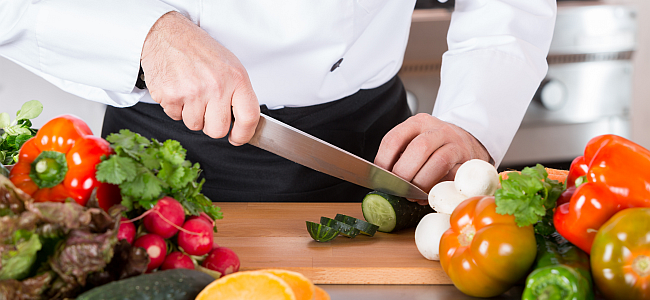When you feel confident in the kitchen, it opens up a world of possibilities to feed your potential. And that confidence often starts with picking up (or brushing up) on cooking basics, including knife skills.
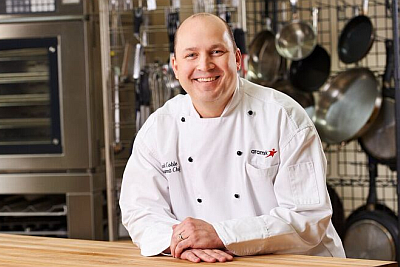 Why? Knowing how to cut fresh vegetables, fruit, herbs, and more will make it easier to prepare healthy meals in your own kitchen.
Why? Knowing how to cut fresh vegetables, fruit, herbs, and more will make it easier to prepare healthy meals in your own kitchen.
If you’re intimidated by the impressive skills of master chefs you see on TV, don’t be!
“That kind of cutting speed and precision are not the goals here,” says Aramark Development Chef Mike Coble. “With the right tools and a little practice, basic cutting techniques are easy to perfect at home.”
Choosing Your Knife
“Someone once told me that you have to have the right tool for the right job,” explains Chef Coble. “Knives are the backbone for any cook, and each has a different use.”
While there are many kinds of knives used for different functions, the stars of your knife block at home should include:
- Chef’s knife: With a broad, gradually tapering blade, this is your kitchen workhorse.
- Paring (or utility) knife: This knife is better for cutting smaller and softer foods like mushrooms. It can also double as a peeler.
- Serrated knife: You’ll know this one by the “teeth” on its long blade. Use a sawing motion to slice bread, thick-skinned fruit like watermelon, and thin-skinned food like tomatoes.
Hold It Steady
To properly hold any knife, “think about how you’d hold a dart,” Chef Coble suggests. Grasp the knife at the ridge that separates the handle from the blade (called the bolster). Place your thumb and forefinger just above this ridge and pinch the back of the blade. Then, gently wrap your remaining three fingers around the handle.
The more you use a knife, the more comfortable it will feel. “But if it feels too big and clunky, it may be just that,” says Chef Coble.
Safety First
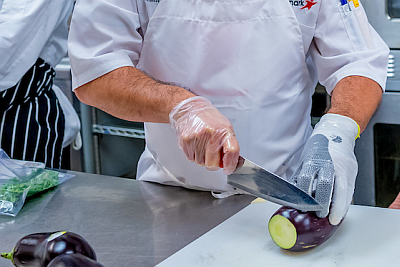 There are two things to remember, Chef Coble notes. The first is to keep your knives sharp. Why? A dull knife requires more pressure—making it more likely to slip and cause an accident. If you’re worried about finger cuts with sharp knives, you can always get a good cut-proof glove.
There are two things to remember, Chef Coble notes. The first is to keep your knives sharp. Why? A dull knife requires more pressure—making it more likely to slip and cause an accident. If you’re worried about finger cuts with sharp knives, you can always get a good cut-proof glove.
The second is to prevent cross-contamination of bacteria and other germs. “This is a big deal,” Chef Coble stresses. “Use a separate cutting board for raw meat, poultry, and seafood. Wash everything, including your knives and countertops, with soap and hot water before you move on to another ingredient.”
Now, let’s cut to the chase! Here are the ins and outs of four common knife techniques, which are the foundation for all cooking.
Slicing
Depending on the food, slices can resemble long pieces (bell peppers), wedges (peaches), or cross-sections (tomatoes for sandwiches). Typically, the goal is to make slices of about equal thickness, especially if the food will be cooked.
- How to do it: Anchor the food with your non-dominant (the one not holding the knife) hand and make equal-sized cuts with your knife. Cut with the full length of your knife and try to keep the tip glued to the cutting board.
- Use it for: Many things! Slice up carrots or apples for a healthy snack. Slice bell peppers, tomatoes, or cucumbers to top a colorful salad. Slice up fruits before throwing them in the blender to make your favorite smoothie. And don’t forget slicing cabbage quickly turns it into a base for your favorite slaw recipe.
- Pro tip: A slicing session on a Sunday night can help you prep meal and snack ingredients for the busy week ahead.
Chopping
Here you’re going for pieces that are about the same size, but not necessarily the same shape. This works when you want the food to cook evenly, but the presentation isn’t so important.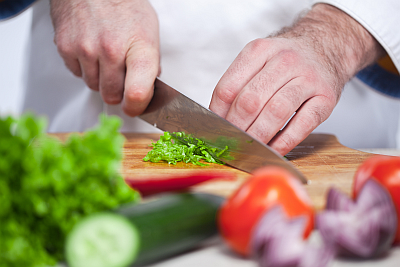
- How to do it: Use a chef’s knife to cut the food into pieces from end to end. Gather up those first pieces to cut them into halves, and again into quarters, as needed.
- Use it for: Cutting up root veggies (such as beets or potatoes) before roasting them for a hearty side dish. Fine chopping (very small bits) is also the best way to prep herbs, which add fresh, sodium-free flavor to homemade soups, marinades, dressings, and more. “A sharp knife is key to chopping herbs, as it keeps their essential oils intact,” Chef Coble explains. “A dull knife will tear them.”
- Pro tip: Sprinkle chopped parsley to elevate any dinner plate, or add chopped mint leaves to your water for zero-calorie refreshment.
Dicing
Dicing goes one step further than chopping. This skill is perfect for achieving small, neat pieces that will cook evenly and blend in. The closer the cuts, the finer the dice.
- How to do it: Using an onion as an example, Chef Coble instructs: “First peel it and cut it in two. Holding it by the root, slice lengthwise, leaving ½-inch at the root end uncut (this keeps the onion in one piece). Finally, turn the onion and slice crosswise.”
- Use it for: Onions, tomatoes, or other veggies that will fill your morning omelet, bulk up your salsas or pasta sauce, or top a homemade pizza (preferably made with whole-wheat crust).
- Pro tip: Watery eyes? Chill your onion in the fridge first, so it will release fewer of the irritants that make you tear up. Running your kitchen’s exhaust fan may also help.
Mincing
Mincing reduces a food to the smallest possible pieces—almost like a crumble.
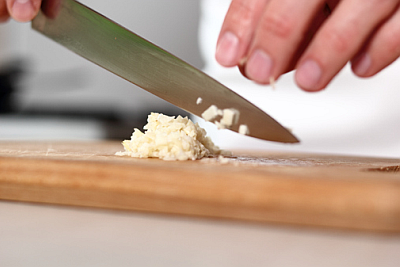
- How to do it: Chef Coble recommends starting with thin slices. Then, rock your knife back-and-forth and side-to-side as many times as it takes to achieve the even consistency you’re looking for. Use your knife to scrape the pieces into a small pile between each pass.
- Use it for: Garlic, ginger, shallots, and other aromatics. When minced, they combine seamlessly with other ingredients for intense flavor in marinades, dressings, and stir-fry
- Pro tip: For a juicy burger patty, mix minced onions or garlic into your lean ground beef, bison, or turkey before grilling.
Note: Since everyone’s health history and nutritional needs are so different, please make sure that you talk with your doctor and a registered dietitian to get advice about the diet and exercise plan that‘s right for you.

